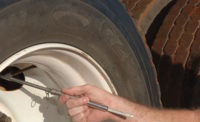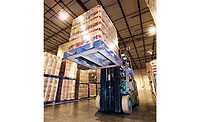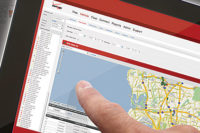Software improves safety, brand image and bottom line for fleet operators
Electronic logging devices mandates further telematics implementation

In the fleet management world, the question no longer is whether beverage companies should implement telematics — it’s how.
Across most industries, companies increasingly are investing in telematics solutions, says Oswaldo Flores, product manager for Teletrac Navman, Glenview, Ill. He attributes the growth mainly to government regulation and a need for efficiency.
In terms of regulation, the U.S. Federal Motor Carrier Safety Administration (FMCSA) recently issued a new mandate that requires commercial drivers and carriers to use electronic logging devices (ELDs) that are self-certified and registered with the FMCSA. According to the FMCSA website: “The [ELD rule] — congressionally mandated as a part of MAP-21 — is intended to help create a safer work environment for drivers, and make it easier and faster to accurately track, manage and share records of duty status (RODS) data. An ELD synchronizes with a vehicle engine to automatically record driving time for easier, more accurate hours of service (HOS) recording.”
The rule is being implemented in three phases. The industry currently is in the second phase, which consists of a two-year phased-in compliance period. During this time, drivers and carriers can use ELDs or automatic on-board recording devices (AOBRDs) that were installed and in use prior to Dec. 18, 2017. After Dec. 16, 2019, all drivers and carriers subject to the rule will be required to use only self-certified ELDs registered with the FMCSA, its website states.
When the mandate was introduced, many beverage companies rushed to implement the technology, says Zodie Rich, enterprise sales director for San Diego-based Lytx Inc.
“These companies quickly realized that the benefits of telematics technology go far beyond compliance, presenting opportunities to drastically improve the safety of their fleets and drivers,” he says.
Telematics Training
As of August 2018, adoption of telematics systems was at an all-time high, with 77 percent of fleet professionals using the technology for vehicle tracking, according to Teletrac Navman’s Telematics Benchmark Report: U.S. Edition. The company surveyed more than 2,400 fleet professionals for its report.
However, in addition to discovering the saturation of telematics in the transportation market, the report found that most fleets are not using telematics to its full potential. Only 29 percent of professionals said they use telematics to monitor fuel usage, and 43 percent said they do not use telematics to measure driver performance. Furthermore, monitoring of speeding, harsh braking and maintenance needs decreased in utilization, according to the report.
“We’re seeing more companies invest in telematics, but unfortunately many are only doing so to check the compliance box, not making the most of the technology to better their businesses,” said Sid Nair, senior director of transport and compliance for Teletrac Navman, in a statement. “…Training everyone from drivers to fleet executives on how telematics data can boost operations is key, as the data alone won’t drive change.”
To ensure its customers get the most from their fleet management solution, Teletrac Navman provides on-demand and live webinar training sessions, Flores says.
“We also provide a software training help tool integrated as part of our software solution called ‘Show Me How,’ which shows users how to set up and use the many features and functions offered within our platform,” he explains. “These are targeted at both managers/administrators and drivers and are all completely free of charge. As a value-added service, we offer on-site training courses for administrative staff and drivers as well as white glove implementation, training and best practices management from our professional services teams.”
Alternately, Lytx ensures its customers are well trained by assigning a client success manager (CSM) to each account.
“CSMs are assigned at initial deployment and add a personal touch to onboarding and providing education around best practices, while getting to know each client’s unique business and safety objectives,” Rich explains. “These [CSMs] work closely with their clients to ensure objectives are met, and often attend training sessions with managers, coaches and drivers themselves to answer questions and communicate new enhancements or offerings.”
All customers are required to be trained in person, notes Doug Hawley, chief operating officer for InSight Mobile Data, California, Md. However, InSight Mobile Data also trains its customers online and includes unlimited training with all of its services for the life of the customer relationship, he says.
Reaping the Rewards
When telematics systems are used to their full potential, a variety of benefits can be achieved. Generally, maximizing efficiency, productivity, safety and brand image while reducing cost is the primary goal for food and beverage companies. As beverage companies prepare for full compliance of the ELD rule, they already are realizing many of these benefits, Lytx’s Rich says. Plus, video telematics adds the benefit of context to provide the full picture of a driving event, he adds.
Specifically, Teletrac Navman’s Flores explains how fleet professionals rank the benefits of telematics systems.
“For companies who use telematics and GPS solutions, when asked to rank what they want to measure based on importance, the most important reason — especially with private fleets — is to monitor driver behavior with the goal of protecting company image and minimizing risk,” he says. “This includes actions like idling, speeding, number of miles driven and unauthorized usage. The ability to monitor location and fuel management are close behind, followed by accurate odometer and engine hours.”
By monitoring driver behavior and increasing efficiency, many operators hope they can offset costs, notes Ray Zujus, customer success executive at Atlanta-based Verizon Connect.
“The explosion of products and SKUs has driven operational costs up,” he says. “As a result, operators are more reliant on connected commercial vehicle software to show them where they can be more efficient and offset costs.”
Luckily, telematics systems typically have a good return on investment (ROI).
“Most customers can begin to see and analyze data almost immediately that will help them make more informed decisions that can ultimately impact their bottom line,” Verizon Connect’s Zujus says.
According to Teletrac Navman’s Flores, its fleet management software has resulted in as much as 30 percent reduced fuel consumption, 20 percent fewer accidents and violations, 12 percent less maintenance and 15 percent improved uptime.
Similarly, Lytx customers reported approximately 625,000 fewer instances of risky driving in 2018 compared with 2017, Rich says.
“Specifically within the beverage distribution industry, one of the country’s largest independent beverage companies, serving 64 million consumers across 16 states, implemented Lytx’s Driver Safety Program at 28 locations in 2017,” Rich notes. “The company already had a low collision frequency but believed telematics could help identify risky behaviors and opportunities for improvement, including challenges the fleet wouldn’t have been able to pinpoint otherwise. During the company’s trial of Lytx, it experienced a 27 percent reduction in frequency and a 25 percent reduction in severity of unsafe driving behaviors — a dramatic improvement for a company that had already demonstrated a strong commitment to safety.”
Utilizing Technology
As carriers and drivers realize the benefits of telematics systems, technology continues to evolve, thereby advancing the telematics market.
“[Telematics] technology has evolved into a much more comprehensive offering that connects the vehicle, the driver and the work, and provides a better picture of the areas in the delivery operation where wasted movement, effort and cost can be identified and removed to free up the resources needed to address these trends,” Verizon Connect’s Zujus explains.
But telematics does more than identify problem areas. Telematics systems today have the ability to connect vehicles to other vehicles, read information directly from vehicle engines on a broader scale, and provide advanced video telematics with driver-assistance systems, distracted driving detection and road sign recognition, InSight Mobile Data’s Hawley says.
“Devices in vehicles are mini computers and are getting smaller, lighter, faster and more powerful each year,” he says. “This continued advancement coupled with lower device and data costs make advancements possible.”
By connecting vehicles to one another and integrating software, fleets can share valuable information to help increase efficiency, productivity and safety.
“One of the most important things telematics companies are doing to make their systems more easily accessible is developing APIs, or application programming interfaces, that ensure their systems can integrate and work with any others,” Teletrac Navman’s Flores says. “With [our DIRECTOR fleet management software], for example, we have an Open API that allows our telematics data to integrate into an entire ecosystem of companies for better information sharing and faster business decisions. This could include integrations with vehicle manufacturers, other software systems, or mobile devices such as tablets or phones to make the telematics system work with whatever hardware a company prefers rather than requiring custom installations.”
Similarly, third-party and aftermarket companies are making data collected from vehicles accessible through cloud-based services, InSight Mobile Data’s Hawley notes. “This assimilation of multiple data sources into singular databases will continue to provide ever-expanding business intelligence that will provide the beverage industry with continuous improvement.”
Making data more accessible — and less costly — already has led to significant growth in the telematics market.
“The telematics industry has been growing more than 17 percent per year for the last five years with little slowdown in sight,” InSight Mobile Data’s Hawley says. “This is driven by powerful trends in increasing mobile capabilities, lower data costs and vehicle connectivity.”
Telematics systems even are able to run on Apple and Android devices that mobile workers already have, Verizon Connect’s Zujus notes.
In the future, experts predict that connected fleets and advanced video telematics will help beverage distribution to be even more efficient, productive and safe.
“Telematics can and will continue to improve operations within the beverage market,” InSight Mobile Data’s Hawley says. “Advancements in technology — especially in video telematics and connected fleets — will drive efficiencies and improve overall organizational performance.”
In fact, Lytx’s Rich expects video telematics to move from a “nice-to-have” to “need-to-have” feature of every fleet. BI
Looking for a reprint of this article?
From high-res PDFs to custom plaques, order your copy today!







